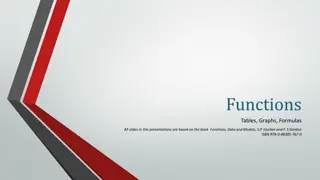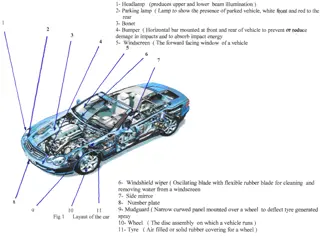Understanding Clutches: Types and Functions
Clutches play a crucial role in connecting and disconnecting driving shafts, with various types like positive and friction clutches. Positive clutches, such as jaw clutches, ensure direct drive, while friction clutches like disk clutches use frictional material to engage and disengage shafts. Learn about single and multiple disk clutches and their mechanisms in this comprehensive guide.
Download Presentation

Please find below an Image/Link to download the presentation.
The content on the website is provided AS IS for your information and personal use only. It may not be sold, licensed, or shared on other websites without obtaining consent from the author. Download presentation by click this link. If you encounter any issues during the download, it is possible that the publisher has removed the file from their server.
E N D
Presentation Transcript
PREPARED BY :- 1) BAPODRA ANAND 2) CHUDASAMA MAYURI 3) GONDALIYA POOJA 4) KAMDIYA POOJA 5) MARDIYA UTSAV 6) DESAI NIKUNJ 7) BHESDADIYA DIXITA
Introduction Introduction : Clutch is a machine member which engage and disengage the driving shaft to driven shaft. The characteristic use of a clutch is to connect two shafts rotating at different speed sand bring the output shaft up to the speed of the input shaft smoothly and gradually. The cone clutch is an axially actuated clutch which is able to transmit a relatively high torque for its size compared to a single disk plate clutch of the same dimensions. This results from the wedging action and increased friction area. Cone clutches are not used widely now and are generally used for low peripheral speed applications.
Clutch is classified into two categories : (1) Positive clutches: (i) jaw clutch. (2) Friction clutches: (i) Disk clutch. (ii) Cone clutch. (iii) Centrifugal clutch.
Positive Clutches :- Positive clutch is used when a positive drive is require. The simplest type of a positive clutch is Jaw clutch.The jaw clutch is permits one shaft to drive another shaft through direct contact of jaw. It consist of two halves, one of which permanently joined with driving shaft. The another half of clutch is moveable and it is free to slide axially on the driving shaft.
Friction Clutches :- Friction clutches are classified below: [1] Disk clutch. (I) Single disk clutch. (II) Multiple disk clutch. [2] Cone clutch. [3] centrifugal clutch.
Single Disc Clutch :- A Single disk clutch , consists of a clutch plate whose both sides are faced with frictional material. The friction disc is arranged between the machined surfaces of the flywheel and the pressure plate when the pressure plate is bolted to the outer edge of the flywheel face. Both the pressure plate and flywheel rotate with driving shaft. The pressure plate pushes the clutch plate towards the flywheel by a set of springs which are arranged radially inside the body. When the clutch pedal is depressed, the movement is transferred through the operating mechanism, to the operating fork and the release bearing.
A multiple disk clutch ,as shown in figure. It may be used when a large torque can be transmitted. There are more than one friction disc arrange parallelly on the driving shaft. The inside discs are joined with driven shaft to permit axial motion. The outside discs are joined with driving shaft. When force on pedal is remove, then discs contact with friction ring and the torque is transmitted between driving shaft and driven shaft.
Cone Clutch :- A cone clutch has a same purpose as a disk or plate clutch. However, instead of mating two spinning disks, the cone clutch uses two conical surfaces to transmit torque by friction. The cone clutch transfers a higher torque than plate or disk clutches action and increased surface area. Cone clutches are generally now only used in low peripheral speed applications although they were once common in automobiles and other combustion engine transmissions.
The cone clutch consists of one pair of friction surface only. The driven member of the clutch arranged on the driven shaft . As per order to engage the clutch and two conical frictional surfaces are comes in contact. Due to frictional resistance set up at this contact surface, the torque is transmitted from driving shaft to driven shaft. Pressure applied by a driving member on outer surface of the driven member by means of friction.
CENTRIFUGAL CLUTCH:- The most common centrifugal clutches have friction pads (shoes) which connect to the inside of the housing. shoe connects to a various amount of extension springs on the center shaft. centrifugal clutch is a clutch that uses centrifugal force to connect two concentric shafts, with the driving shaft nested inside the driven shaft. The increase of speed causes the press harder and more torque can be transmitted. A centrifugal clutch is used on most racing go-karts.
Material used in clutch :- Various materials have been used for the disc friction facings, including asbestos in the past. Frictional material used in clutch should have a high and uniform coefficient of friction. Modern clutches typically use an Organic_compound. organic resin with copper wire facing or a ceramic material. Ceramic materials are typically used in heavy applications such as trucks carrying large loads or racing though the harder ceramic materials increase flywheel and pressure plate wear.
Thank You GUIDE BY :- Prof. Ankit v. Sata 14























